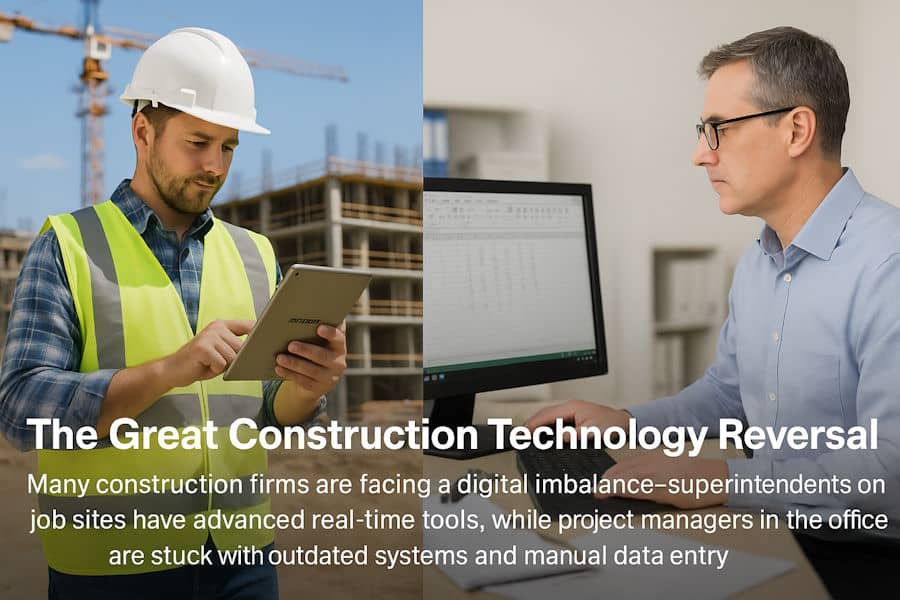Your field superintendent is tracking RFIs through Procore on his iPad, capturing daily progress with drone footage, and coordinating subcontractors via real-time scheduling apps. Meanwhile, back at the office, your project manager is still fighting with Excel spreadsheets, manually compiling reports from three different systems, and spending 6 hours every Friday just trying to figure out where the project actually stands.
This technology role reversal is happening at construction companies everywhere, and it's creating a bizarre situation where the people closest to the dirt have better digital tools than the people managing the money. Most IT services and solutions for construction completely miss this inversion - and it's costing firms millions in coordination failures, duplicated effort, and PM burnout.
Let me explain why this is happening and what it means for your operation.
The Great Construction Technology Reversal
Twenty years ago, office staff had all the technology advantages - powerful computers, fast networks, specialized software. Field crews had paper, pencils, and maybe a fax machine in the trailer.
Today? Complete flip.
The Field Technology Explosion
Modern superintendents have access to:
- Construction management apps with instant data capture
- Mobile devices more powerful than office PCs from 5 years ago
- Cloud-based collaboration tools designed for jobsite use
- BIM viewers that work flawlessly on tablets
- Real-time communication platforms built for field conditions
These tools were purpose-built for construction field work, and they're genuinely good.
The Office Technology Lag
Meanwhile, back at headquarters, PMs are stuck with:
- Legacy project management software from 2008
- Desktop applications that can't talk to field tools
- Reports that require manual data compilation from multiple sources
- Systems that were "implemented" but never properly integrated
- IT services and solutions for construction that prioritize stability over innovation
The result? Your superintendent has a real-time view of the project while your PM is working with day-old data at best.
The Hidden Costs of This Technology Gap
This isn't just an inconvenience - it's creating fundamental operational problems that most construction companies don't even recognize.
The Data Translation Tax
Every day, information flows from field to office:
- Superintendent enters progress in mobile app
- PM manually transfers data to their tracking system
- Accounting needs the same information in different format
- Executives want dashboard views that require another manual compilation
For a typical project, this data translation costs:
- 8-12 hours of PM time weekly
- Countless errors from manual data entry
- Delayed decision-making due to information lag
- Frustrated superintendents who wonder why they bother using digital tools
The Decision-Making Time Warp
Your superintendent knows in real-time that:
- The concrete pour is delayed 2 days
- Mechanical rough-in is ahead of schedule
- That change order work is actually complete
Your PM finds out about these things when? During the weekly coordination meeting, or worse, when they finally compile all the reports on Friday afternoon.
By the time decisions get made, the opportunities are gone and the problems have compounded.
The Talent Retention Disaster
Here's something most IT services and solutions for construction providers don't consider: your best PMs are getting poached by companies that give them modern tools.
Young PMs especially aren't willing to manually compile reports when they know technology exists to automate this. They're leaving for competitors who've figured out the office technology piece.
Why Traditional IT Services Miss This Problem
The technology gap persists because most IT services and solutions for construction approach the industry backwards.
The Field-First Fallacy
IT providers see construction companies buying field technology and assume that's where the problems are. So they focus on:
- Improving jobsite connectivity
- Mobile device management
- Field app integration
- Digital plan rooms
All important, but meanwhile, the office technology stack is held together with duct tape and prayer.
The "Integration Later" Lie
Here's the typical deployment:
- Implement awesome field technology
- Promise to "integrate with existing office systems"
- Discover those office systems are incompatible
- Create manual workarounds "temporarily"
- Temporary becomes permanent
Those temporary workarounds? That's where your PM's career satisfaction goes to die.
The Missing Orchestration Layer
Quality IT services and solutions for construction need an orchestration layer that:
- Automatically syncs field data to office systems
- Translates between different platforms and formats
- Provides unified dashboards across all data sources
- Eliminates manual data entry and compilation
Most providers either don't know this exists or don't want to implement it because it's complex.
What Actually Needs to Happen
Fixing this technology inversion requires rethinking how IT services and solutions for construction are designed and deployed.
The Office Technology Upgrade
Your office staff needs tools as modern as your field tools:
- Cloud-based project management platforms that integrate natively with field apps
- Automated reporting systems that pull data from all sources
- Real-time dashboards that don't require manual updates
- AI-assisted tools for schedule analysis and risk identification
This isn't about fancy features - it's about eliminating the manual drudgery that's consuming PM time.
The True Integration Implementation
Real integration means:
- Field data flows automatically to office systems
- Changes in one system update all related systems
- No manual data entry or translation required
- Bidirectional communication (office can push updates to field)
When done right, your PM sees the same real-time project status as your superintendent - just with different analytical tools on top of it.
The Role-Appropriate Tool Design
Stop giving PMs field tools and hoping it works:
- Superintendents need mobile, quick-capture, visual tools
- PMs need analytical, forecasting, integration-heavy tools
- Executives need strategic, high-level, trend-analysis tools
Quality IT services and solutions for construction provide appropriate tools for each role, not one-size-fits-all platforms.
The Real-World Impact of Getting This Right
When construction companies properly address the office technology lag, remarkable things happen:
The Time Liberation
A commercial GC implemented proper office technology integration:
- PM report compilation time: 6 hours → 20 minutes
- Time spent chasing field updates: 8 hours weekly → 0
- Data entry and verification: 10 hours weekly → automated
- Result: PMs managing 2 additional projects each
The Decision Speed Transformation
A residential builder connected field and office tools properly:
- Change order response time: 3-5 days → same day
- Schedule adjustment decisions: weekly → as-needed
- Budget variance detection: monthly → weekly
- Impact: 23% improvement in project margins
The Retention Revolution
After modernizing PM tools to match field technology:
- PM satisfaction scores increased 47%
- Turnover dropped from 35% to 12% annually
- Recruiting became easier (modern tools are a selling point)
- Experienced PMs stopped leaving for competitors
What to Demand from IT Services and Solutions Providers
If you're evaluating IT services and solutions for construction, here's what you need to ask about office technology specifically:
Critical Requirements:
- "Show me how field data automatically populates PM dashboards"
- "Demonstrate real-time project status without manual updates"
- "Explain how your solution eliminates data re-entry"
- "Prove that office staff can actually use these tools efficiently"
Integration Verification:
- "How many manual steps are in your data flow process?"
- "What happens when field and office data conflicts?"
- "Can PMs modify schedules and have it automatically update field apps?"
- "Show me actual PM workflows, not just feature lists"
ROI Confirmation:
- "How much PM time will this save weekly?"
- "What's the typical reduction in report compilation time?"
- "How does this affect PM capacity and project loads?"
- "Can you provide references from PMs (not just executives)?"
The Path Forward
Here's how to fix the superintendent-better-tools-than-PM problem:
Step 1: Audit the Reality
Document exactly what your superintendent can do with their tools versus what your PM can do. The gap will be shocking.
Step 2: Define Office Requirements
List what PMs actually need:
- Automated data compilation from all sources
- Real-time project status visibility
- Predictive analytics and forecasting
- One-click reporting and dashboards
Step 3: Demand True Integration
Don't accept "we'll integrate later" or "manual export/import." Insist on real-time, bidirectional, automated integration.
Step 4: Prioritize PM Experience
Test everything from the PM perspective. If it doesn't make their job dramatically easier, it's not the right solution.
The Bottom Line
Your superintendent having better tools than your PM isn't progress - it's a half-completed digital transformation that's creating more problems than it solves.
Modern IT services and construction solutions must recognize that field technology is only half the equation. Without corresponding office technology upgrades, you're just creating a data bottleneck that shifts from the jobsite to the project manager's desk.
The goal isn't to give everyone the same tools. It's to give everyone the RIGHT tools that work together seamlessly. Your superintendent needs mobile, field-optimized technology. Your PM needs analytical, integration-heavy, automation-focused technology.
When both roles have appropriate, properly integrated tools, that's when construction technology finally delivers on its promise. Anything less is just shifting the workload around while calling it innovation.
Fix the office technology. Your PMs will thank you, your projects will run smoother, and your superintendent's fancy iPad will actually serve its full purpose instead of just generating data that someone has to manually enter somewhere else.








